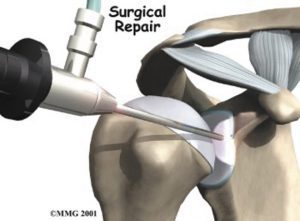By Regenexx Tampa Bay, Regenerative Medicine
 Today’s orthopedic care model, much like the healthcare model in general, often treats the symptoms of an orthopedic issue without addressing the root cause of the problem.
Today’s orthopedic care model, much like the healthcare model in general, often treats the symptoms of an orthopedic issue without addressing the root cause of the problem.
This is true of shoulder labral tears. The usual treatment prescribed by orthopedists is a repair surgery but the cause of the tear is never addressed during the patient’s brief consultation with the doctor.
What Is the Shoulder Labrum?
The shoulder labrum is like a seal that surrounds the shoulder joint’s socket. Because its purpose is to guide the shoulder joint as it moves and to make the shallow socket slightly deeper, it serves as a shoulder stabilizer. In decades past, a tear in the labrum wasn’t considered a serious issue—It was simply a shoulder arthritic condition. Once orthopedic surgeons realized a torn labrum could be resewn, shoulder labral surgery became more commonplace. Frequently, a labral tear does need to be tended to, and more than likely, surgical repair is not the answer.
What Caused Your Labrum to Tear?
Labral tears can happen as a result of a traumatic incident, such as a car wreck or a major fall. It’s not unusual, however, for tears to occur without any fanfare or particularly notable injury. What causes a tear in those cases? Hidden shoulder instability is the probable culprit.
With insurance companies and managed care telling orthopedic surgery clinics how to operate, patients generally get little time with their surgeon. Most of their appointment is spent with an assistant. This means that important details like why your labrum tore in the first place are never discussed.
Why Does Shoulder Instability Matter?
The shoulder is a complex joint. It has to be able to move in several different directions at maximum capacity, yet it also needs to be stable. Timing and precision are paramount to ensure that the ball (humeral head of shoulder) remains in a small space relative to the socket when moving the shoulder.
The rotator cuff and other muscles contribute to this, but strong ligaments also help keep the ball joint resting just where it should in the shallow socket.
On the whole, surgeons ignore these ligaments until the joint gets dislocated. For every patient who has a dislocated shoulder and a very unstable joint, five or six other people have undiagnosed hidden shoulder instability.
Frequently, it stems from an injury long ago that the person did nothing about. The shoulder might have seemed to heal but it resulted in an unknown labral tear or underlying shoulder instability.
This is one of the most egregious cons when evaluating shoulder labral tear surgery: hidden shoulder instability.
Read the Stories of Two Patients
Hidden shoulder instability is a common condition that most orthopedic evaluations completely miss.
Two patients with different stories but similar outcomes illustrate some of the reasons. One 20-something patient with hidden shoulder instability visited a Regenexx office to help him decide whether to undergo labral tear surgery.
His current injury happened during a rock-climbing workout that left him in chronic pain. When the Regenexx doctor examined the patient, it was discovered that the shoulder ball was unstable in the socket. What caused the instability that led to his recent labral tear?
Upon speaking further with the patient, he recalled a bad mountain bike fall that occurred seven years before. His shoulder was injured but he never sought medical treatment. Oftentimes when someone has an injury and they do no corrective exercise or rehab after the injury, this can lead to underlying instability.
Another patient, also an athletic man, had torn his left shoulder labrum as he dead-lifted 450 pounds. His right shoulder was perfectly fine, however. What caused the difference between the shoulders when they lifted the same poundage?
After examining the left shoulder, again hidden shoulder instability was the diagnosis. Damage inflicted during an MMA fight the year before had caused pain for weeks but the patient ignored the pain and did nothing to help the issue.
What Are the Consequences of a Shoulder Labrum Surgery if You Have Hidden Shoulder Instability?
If the root cause of a labral tear is hidden shoulder instability, then shoulder labral surgery will only temporarily solve the issue. The next time the unstable shoulder has to deal with another potentially challenging situation, the socket will move out of its place and tear the labrum again.
What is the long-term solution then? In short, it’s interventional orthopedics. By precisely injecting your own advanced platelet and healing cell mixtures directly into the torn labrum and the loose ligaments, your body can heal itself.
This procedure comes with a much shorter recovery time and the results are often better than those achieved with surgical repair, while also taking care of the hidden shoulder instability.
It’s a win-win scenario that will serve you much farther into the future than the short-term shoulder labrum surgery solution.
Visit www.NewRegenOrtho.com to learn more.
 Central Florida Health and Wellness Magazine Health and Wellness Articles of the Villages
Central Florida Health and Wellness Magazine Health and Wellness Articles of the Villages


